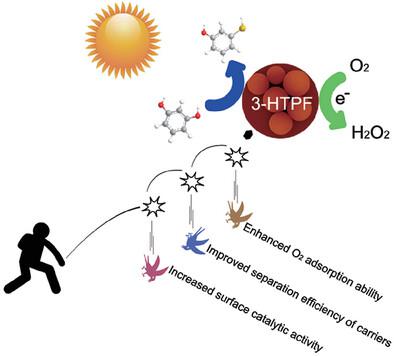Our official English website, www.x-mol.net, welcomes your feedback! (Note: you will need to create a separate account there.)
3-Hydroxythiophenol-Formaldehyde Resin Microspheres Modulated by Sulfhydryl Groups for Highly Efficient Photocatalytic Synthesis of H2O2
Advanced Science ( IF 14.3 ) Pub Date : 2023-12-10 , DOI: 10.1002/advs.202304948 Yulu Xu 1 , Xia Hu 2 , Yuyuan Chen 1 , Sijie Lin 1 , Chen Wang 1 , Faliang Gou 1 , Xiaogang Yang 3 , Weiwei Zheng 4 , De‐Kun Ma 1
Advanced Science ( IF 14.3 ) Pub Date : 2023-12-10 , DOI: 10.1002/advs.202304948 Yulu Xu 1 , Xia Hu 2 , Yuyuan Chen 1 , Sijie Lin 1 , Chen Wang 1 , Faliang Gou 1 , Xiaogang Yang 3 , Weiwei Zheng 4 , De‐Kun Ma 1
Affiliation

|
Resorcinol-formaldehyde (RF) resin represents a promising visible-light responding photocatalyst for oxygen reduction reaction (ORR) toward H2O2 production. However, its photocatalytic ORR activity toward H2O2 generation is still unsatisfied for practical application. Herein, 3-hydroxythiophenol-formaldehyde (3-HTPF) resin microspheres synthesized through polycondensation reaction between 3-HTP and formaldehyde at room temperature and subsequent hydrothermal treatment exhibit enhanced photocatalytic ORR activity is reported. The experimental results show that the partial substitution of hydroxy group (─OH) by sulfhydryl one (─SH) through using 3-HTP to replace resorcinol could slow the rates of nucleation and growth of the resin particles and lead to strongly π-stacked architecture in 3-HTPF. The introduction of ─SH group can also improve adsorption ability of 3-HTPF to O2 molecules and enhance ORR catalytic activity of the photocatalysts. Stronger built-in electric field, better adsorption ability to O2 molecules, and increased surface catalytic activity collectively boost photocatalytic activity of 3-HTPF microspheres. As a result, H2O2 production rate of 2010 µm h−1 is achieved over 3-HTPF microspheres at 273 K, which is 3.4 times larger than that obtained using RF submicrospheres (591 µm h−1). The rational substituent group modulation provides a new strategy for designing polymeric photocatalysts at the molecular level toward high-efficiency artificial photosynthesis.
中文翻译:

巯基调控的3-羟基苯硫酚-甲醛树脂微球高效光催化合成H2O2
间苯二酚-甲醛 (RF) 树脂代表了一种有前景的可见光响应光催化剂,用于氧还原反应 (ORR) 生成 H 2 O 2。然而,其光催化ORR生成H 2 O 2的活性仍不能满足实际应用的需要。据报道,通过3-HTP和甲醛在室温下的缩聚反应以及随后的水热处理合成的3-羟基苯硫酚-甲醛(3-HTPF)树脂微球表现出增强的光催化ORR活性。实验结果表明,用3-HTP取代间苯二酚,将羟基(─OH)部分取代为巯基(─SH),可以减缓树脂颗粒的成核和生长速率,形成强π堆积结构。在 3-HTPF 中。─SH基团的引入还可以提高3-HTPF对O 2分子的吸附能力,增强光催化剂的ORR催化活性。更强的内置电场、更好的O 2分子吸附能力以及增强的表面催化活性共同提高了3-HTPF微球的光催化活性。结果, 3-HTPF微球在273 K下实现了2010 µ m h -1的H 2 O 2生产率,这比使用RF亚微球(591 µ m h -1)获得的H 2 O 2 生产率高3.4倍。合理的取代基调制为在分子水平上设计聚合物光催化剂以实现高效人工光合作用提供了新的策略。
更新日期:2023-12-11
中文翻译:

巯基调控的3-羟基苯硫酚-甲醛树脂微球高效光催化合成H2O2
间苯二酚-甲醛 (RF) 树脂代表了一种有前景的可见光响应光催化剂,用于氧还原反应 (ORR) 生成 H 2 O 2。然而,其光催化ORR生成H 2 O 2的活性仍不能满足实际应用的需要。据报道,通过3-HTP和甲醛在室温下的缩聚反应以及随后的水热处理合成的3-羟基苯硫酚-甲醛(3-HTPF)树脂微球表现出增强的光催化ORR活性。实验结果表明,用3-HTP取代间苯二酚,将羟基(─OH)部分取代为巯基(─SH),可以减缓树脂颗粒的成核和生长速率,形成强π堆积结构。在 3-HTPF 中。─SH基团的引入还可以提高3-HTPF对O 2分子的吸附能力,增强光催化剂的ORR催化活性。更强的内置电场、更好的O 2分子吸附能力以及增强的表面催化活性共同提高了3-HTPF微球的光催化活性。结果, 3-HTPF微球在273 K下实现了2010 µ m h -1的H 2 O 2生产率,这比使用RF亚微球(591 µ m h -1)获得的H 2 O 2 生产率高3.4倍。合理的取代基调制为在分子水平上设计聚合物光催化剂以实现高效人工光合作用提供了新的策略。











































 京公网安备 11010802027423号
京公网安备 11010802027423号